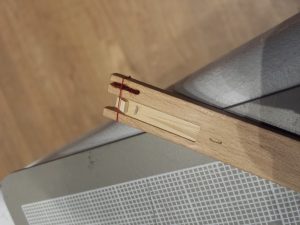Fixing jacks
February 16th, 2018
I’m working on a substantial rebuild of the action of a harpsichord here in Montreal, and keep running into unexpected frustrations. First off, the jacks:
I knew that the jacks were a problem from the start – many performers have complained about the repetition being unpredictable. With a little fiddling, I figured out that what’s happening is that, when the jacks drops past the string, the tongue goes flying back far more than necessary, to the extent that it isn’t back in position to play again when you might want it to. On some jacks, this is controlled by the toe of the tongue hitting the inside of the register, on others, it just isn’t a problem because of the geometry. Some discussions on Facebook have led me to believe that a small distance, less than 10mm, between plectrum and axle can help a lot here, and these jacks have closer to 15mm.
A more common fix for this is a staple or thread limiting the motion of the tongue, and many of these jacks had a thread fitted around them:
Unfortunately, most of them were far too loose to actually do any good. In a few cases, small pads (felt, leather, cardboard…) had been glued to the backs of the tongues to stop them against the thread sooner, and this is what I started doing:

Before I got to far though, I realized that the thread’s position was also going to be a problem! It’s so high that it will inevitably get in the way of the dampers. Also, a loose thread is never going to stay in position properly, so it won’t work consistently. Eventually, I decided to get rid of the threads entirely, and simply glue on little strips of cardboard across the back of each jack:

It’s a little ugly, but works much better than the thread did, and is doesn’t get in the way of work on plectra or dampers as much. The only real downside, besides the aesthetics, is that it probably won’t last as long as a well-attached thread would. If one comes of though, it’s very easy to replace, so I think overall, it’s an improvement!
The next steps with this harpsichord have been to rebalance the keys (so much unnecessary lead!), completely redo the stagger and replace most of the plectra. It’s been a huge job, with four ranks of jacks (224 all together), made much worse because of little inconsistencies in the original construction that I keep discovering. A few of the mortises in the tongues were punched off-centre, making them very prone to splitting for example. Also, many of the tongues aren’t sitting properly in the tongue body, leaning forward or backwards, making it very hard to voice the plectra, since they are very inconsistent lengths. Adding to this is the strings which have been rather inaccurately pinned to the nut. I considered repinning the worst of them, but there just isn’t much room in some places, and I didn’t want to add yet more time to what has turned into a very big job!
